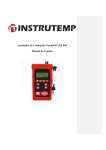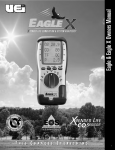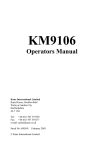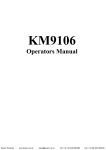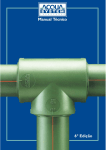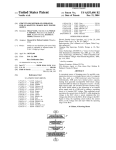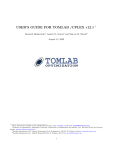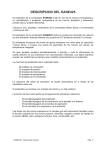Download UEi EagleX Specifications
Transcript
OWNERS MANUAL & MAINTENANCE
SAFE TY NOT ES
Before using this meter, read all safety information carefully. In this manual the word "WARNING" is used
to indicate conditions or actions that may pose physical hazards to the user. The word "CAUTION" is used
to indicate conditions or actions that may damage this instrument.
WARNING!
This analyzer extracts combustion gases that may be toxic in relatively low concentrations. These gases are
exhausted from the back of the instrument. This instrument must only be used in we l l - ventilated locations.
It must only be used by trained and competent persons after due consideration of all the potential hazards.
PREFL IGH T CHECKL IST
•
•
•
•
•
•
•
•
Clean particle filter
• Setting Inlet Temperature
Water trap and probe line are empty of water
- Turn on and zero the analyzer with
Power on and zero
out the flue probe connected to use
All hose and thermocouple connections are properly secured
ambient temperature
Flue gas probe is sampling ambient FRESH air
- Connect flue probe thermocouple to
Water trap is fitted correctly to the instrument
T1 during zero countdown to store
Flue temperature plug is connected
probe tip temperature as inlet
Inlet temperature probe is connected if required
(ducted system)
ANALYZER CONNEC T IONS
NOTE: Take care when inserting the temperature
probes as the pins are polarized. In s e rt with the
smaller pin (+) to the right. See diagram to right.
WARNING!
Turning the pump off while the probe is in the flue
will leave toxic gases inside the analyzer. Once data
has been printed or copied it is advisable to purge the
unit with fresh air as soon as possible. To do this,
with the probe removed from the flue, turn ON the
pump. Always allow the readings to return to zero
(20.9 for O2) prior to shutting the unit off. The
meter will not switch off until the CO reading is
below 20 ppm.
WARNING!
The probe will be hot from flue gases. Remove the
probe from the flue and allow it to cool naturally. Do
not immerse the probe in water, as this will be drawn
into the analyzer and damage the pump and sensors.
Once the probe is removed from the flue and the
readings have returned to ambient levels hold down
“On/Off” and switch off the analyzer. The
i n s t rument will count down from 30 to switch off. If
you pressed “On/Off“ by mistake, pressing “Send“
will return you to normal operation.
Temperature Connections
• Flue Probe Temp: T1
• Inlet Temp: T2
Battery Charge/AC
Power Adapter
Flue Gas Inlet
Connection
Pressure Connections
• Single Input (Draft): P1
• Differential Input Testing
(Pressure drop test) P2
Watertrap drain
Flue Probe Temperature Plug
(Plugs into T1)
Flue Probe Gas Inlet Plug
Narrow Pin MUST be on the
Right hand side.
POST FL IGHT
• Remove the probe from the flue and allow the analyzer to purge with fresh air until readings return to zero.
- O2 to 20.9%, CO to Zero (Be careful as the probe tip will be HOT)
• Drain water trap
• Check particle filter
2
1 . 8 0 0 . 5 4 7 . 5 7 4 0
•
W W W . U E i T E S T . C O M
EAGLE COMBUSTION ANALYZER™ OVERVIEW
Infrared Printer Port
Worklight
Display Line Lights
Backlit 4 Line Display
Navigation Buttons
Function Buttons
Rotary Selector Dial
Battery Compartments
in back under boot
AC Power/Charge
Indicator Light
Protective Rubber Boot
w/ built-in Magnets
Particle Filter
Inside Watertrap
Water Trap
Easy Access Connections
(Flue Probe, Temperature, Pressure, AC Adapter, & Watertrap Drain)
3
GENERAL MAINTENA NCE
•
•
•
•
Calibrate your instrument annually to ensure it meets original performance specifications
Keep your instrument dry. If it gets wet, wipe dry immediately. Liquids can degrade electronic circuits
Whenever practical, keep the instrument away from dust and dirt that can cause premature wear
Although your instrument is built to withstand the rigors of daily use, it can be damaged by severe
impacts. Use reasonable caution when using and storing the meter
PERIODIC SERVICE
WARNING!
Repair and service of this instrument is to be performed by qualified personnel only. Improper repair or
service could result in physical degradation of the instrument. This could alter the protection from personal
i n j u ry this meter provides to the operator. Perform only those maintenance tasks that you are qualified to do.
ANNUA L RE-CALIBRAT ION
While the sensor has an expected life of more than two years in normal use it is recommended that the
analyzer is re-calibrated at least annually, This is so that long-term drift on the sensor and electronics can be
eliminated. Local regulations may require more frequent re-calibration and users should check with
appropriate authorities to ensure the comply with relevant guidelines.
CLEA NING
Periodically clean your instruments case using a damp cloth. DO NOT use abrasive, flammable liquids,
cleaning solvents, or strong detergents as they may damage the finish, impair safety, or affect the reliability
of the structural components.
EMPTYING & CLEA NING THE IN-LINE WATER TRAP
The in-line water trap should be checked and emptied on a regular basis. Water vapor will condense in the
probe line, which may cause the water trap to fill suddenly if the probe is moved. Care should be taken
at all times.
Carefully remove the rubber plug from the bottom
of the water-trap housing. Dispose of the condensate in
a suitable drain, care must be taken as it could be acidic.
If condensate spills onto the skin or clothing, clean off
immediately using fresh water, seek medical advice
if problems occur. Ensure plug is replaced before
performing combustion tests. Note: O2 reading will
be high if the Watertrap Plug is not in place.
Hook slides
out of dock
Slide outward
Pull plug out
to drain
CHA NGING THE PART ICLE FILT ER
This is a ve ry important part of the analyzer and should be changed regularly. It prevents dust and dirt
particles from entering the pump and sensors that will cause damage. The filter MUST be changed when
it appears discolored on the inner surface.
Remove water-trap assembly from the analyzer
as shown above. Remove the filter and plastic
holder from the housing. Discard the filter
element but keep the holder to fit to the new
filter. Clean the inside of the filter housing
with a suitable soft cloth. Fit the holder onto
the new filter element and then insert into the
housing. Refit the housing onto the analyzer.
4
Insert a new filter
1 . 8 0 0 . 5 4 7 . 5 7 4 0
•
W W W . U E i T E S T . C O M
BATTERIES REPLACEMENT
This meter has been designed for use with both alkaline
and rechargeable Nickel Metal Hydride (NiMH) batteries.
No other types are recommended. The analyzer is supplied
with 4 “AA” size alkaline batteries.
These should be installed into the instrument as shown
in the diagram to the right and indicated on the back of
the unit.
Note: Follow battery
directions on back of
housing
C75 Directions
C125/C127 Directions
OR
Back of
Instrument
Battery Compartment
CAUTION!
Take great care when installing the batteries to observe
correct polarity. Always check the meter for operation
immediately after installing new batteries.
Cover
USING RE-CHA RGABLE BATTERIES
The battery charger must only be used when NiMH batteries are fitted. Alkaline batteries are not
re-chargeable. Attempting to recharge alkaline batteries may result in damage to the product and may
create a fire risk.
BATTERY CHA RGING
Ensure that you use the correct charger. This unit uses a 9V DC regulated charger.
Ensure that the batteries are fitted in the correct manner, and then charge for at least 16 hours. Subsequent
charges should be overnight. NiMH batteries may be charged at any time, even for short periods to
conduct testing.
WARNING!
Under NO circumstance should you expose batteries to extreme heat or fire as they may explode and cause
i n j u ry. Always dispose of old batteries promptly in a manner consistent with local disposal regulations.
ELEC T ROMAGNETIC COMPAT IBILITY ( EMC )
This product has been tested for compliance with the following generic standards:
EN 50081-1, EN 50082-1 and is certified to be compliant.
The European Council Directive 89/336/EEC requires that electronic equipment does not generate
electromagnetic disturbances that exceed defined levels and has an adequate level of immunity to enable it to
be operated as intended.
Since there are many electrical products in use that pre-date this Directive and may emit electromagnetic
radiation in excess of the standards defined in the Directive there may be occasions where it would be
appropriate to check the analyzer prior to use. The following procedure should be adopted.
•
•
•
•
Go through the normal start up sequence in the location where the equipment is to be used
Switch on all localized electrical equipment that might be capable of causing interference
Check that all readings are as expected (a level of disturbance in the readings is acceptable)
If not, adjust the position of the instrument to minimize interference or switch off, if possible, the
offending equipment for the duration of the test
At the time of writing this manual (July 2006) UEi is not aware of any field based situation where such
interference has ever occurred and this advice is only given to satisfy the requirements of the Directive.
5
WHY TEST WITH EAGLE COMBUSTION ANALYZERS™
VERIF Y PROPER OPERAT ION OF COMBUST ION EQUIPMENT
• To verify that equipment is operating as the manufacture designed it to work. This includes installation
tests for CO, CO2, O2, Excess Air and stack temperatures
- A properly tuned combustion appliance will perform better, and reduce the likelihood of
call-backs for no-heat
• To verify that the maintenance work performed has corrected the problem
- A print-out documents the before-after improvement in performance
• To detect any defects early – possibly at installation
- Higher efficiency equipment is running at peak only when properly adjusted. As the complexity
of a system increases, so does the importance of proper adjustment of the combustion process.
• Improperly adjusted equipment not only fails to meet expected performance but could lead to future failures
- High CO readings throughout the burner operation could be from a burner that isn’t aligned or
a flame impingement problem
• To check that the equipment is supplied with enough combustion air, make-up air and has proper
venting to exhaust the combustion by-products
• To determine if emissions are within acceptable levels. Governing organizations such as the AGA have
various requirements such as a 400 ppm CO Air Free reading on gas range oven vents
• To check heat exchangers for cracks.
- A breach in the heat exchange may result in CO, O2 and Excess Air values that change after the
blower turns on. This is due to an introduction of additional fresh air into the stack gases from
the positive pressure pushing fresh air into the flue. The Eagle II and III have a test procedure
programmed into the instrument that allow you to capture these values and printout a
comparison of the before and after levels. A change in these values warrants a further look
into the problem
• To monitor the operation during start-up and shutdown.
- Many problems with burners may show an increase in CO at these points earlier than when the
equipment is at operating temperature. A slight rise in CO during these times may be typical,
but anything over 400 would indicate a problem.
• To establish a base-line of desired performance
- By tracking the performance over time you are able to see changes before they lead to
equipment failure.
VERIF Y SA FE OPERAT ION OF COMBUST ION EQUIPMENT
• Equipment that is not properly adjusted, or that has insufficient draft to vent combustion gases could
produce carbon monoxide in deadly quantities. The UEi Eagle Series test both flue gas and ambient
levels of carbon monoxide. A specific test is programmed into the Eagle II and Eagle III to measure
CO levels over a 30-minute period, and provides a printout to document your test results.
• When customers complain about fumes it is usually an indication of improper operation. CO is a
colorless, odorless gas so the fumes are not the CO, but an indication that a problem may exist.
IMPROVE YOUR PRODUC T I VI TY & PROFI T
• The UEi Eagle combustion analyzers give a quick, continuous readout of the combustion process.
Readings change in real-time as adjustments are made to help zero in on the proper setting. Compare
this to spot tests or other methods, and you will see your productivity rise.
• Proper testing with documented results will help you provide the proper service or equipment replacement
recommendations, and have the data to support this. Sales will increase because you are no longer
guessing, and the work provided is proper for the needs of the customer.
• Customers on a service contract will be provided excellent service, and you will quickly diagnose failures
and help keep the equipment up for the season.
IMPROVE CUSTOMER PERCEPT ION OF YOUR SERVICES
• Provide your customers documented results of the performance of their equipment
• Reduce your customers energy expense by properly adjusting and maintaining their equipment
• Increase your confidence in the work performed and remember
6
IF YOU DON’T TEST, YOU DON’T KNOW
1 . 8 0 0 . 5 4 7 . 5 7 4 0
•
W W W . U E i T E S T . C O M
WHAT RESULTS ARE GENERALLY ACCEPTABLE
ATMOSPHERIC GAS FIRED BURNERS
•
•
•
•
Oxygen ............................................................................. 7 to 9% O2
Stack Temperature ......................................................... 325 to 500°F
Draft (Water Column Inches) .......................................... -.02 to -.04wc”
Carbon Monoxide ( p a rts per million) ............................ <100ppm
GAS FIRED POWER BURNERS
•
•
•
•
•
Oxygen ............................................................................. 3 to 6% O2
Stack Temperature ......................................................... 275 to 500°F
Stack Draft (Water Column Inches)................................ -.02 to -.04wc”
Overfire Draft (Water Column Inches)........................... -.02wc”
Carbon Monoxide ( p a rts per million) ............................ <100ppm
OIL FIRED BURNERS (#2 OIL FUEL)
•
•
•
•
•
•
Oxygen ............................................................................. 4 to 7% O2
Stack Temperature ......................................................... 325 to 600°F
Stack Draft (Water Column Inches)................................ -.04 to -.06wc”
Overfire Draft (Water Column Inches)........................... -.02wc”
Carbon Monoxide ( p a rts per million) ............................ <100ppm
Smoke .............................................................................. 0 (or manufacturer’s recommendation)
POSITIVE OVERFIRE GAS & OIL
•
•
•
•
Oxygen ............................................................................. 3 to 9% O2
Stack Draft (Water Column Inches)................................ -.02 to -.04wc”
Overfire Draft (Water Column Inches)........................... +0.4 to +0.6wc”
Carbon Monoxide ( p a rts per million) ............................ <100ppm
NOTE: Follow manufacture guidelines for the specific equipment being serviced.
SAMPLE PRIN T OUTS / REPORTS
Combustion
Test
Heat Exchanger
Test
Differential
Temperature Test
Manometer
Draft/Pressure Test
Room CO
Test
7
WHERE TO TEST
AIR CONDI T IONING / HEAT PUMP
Suction Line:
• Temperature
Verify proper:
• Static Duct Pressures
• Temperature Differential
• Static Pressure Drop Across Coils
to condensing unit
BOILER & WATER HEATERS
WATER HEATER
Draft
BOILER
Verify proper combustion:
• O2
• CO Air Free
• Stack Temp
• Stack Draft
• SSE
Verify proper combustion:
• O2
• CO
• Stack Temp
• Efficiency
FURNACES: 80 %
80% FURNACE
Verify proper combustion:
• O2
• CO
• Stack Temp
• Vent Pressure
• Efficiency
Set Up
• Gas Pressure
Test
• Limit Switch
• Pressure Switch
Verify proper combustion:
• Static Duct Pressure
• Temperature Rise
• AC side Static Pressure Drop across coils
8
1 . 8 0 0 . 5 4 7 . 5 7 4 0
•
W W W . U E i T E S T . C O M
FURNACES (CON T INUED): ATMOSPHERIC, GAS & OIL
ATMOSPHERIC FURNACE
Draft
Verify proper
• Temperature Rise
• AC side Static Pressure Drop across coils
Verify proper combustion:
• O2
• CO
• Stack Temp
• Efficiency
GAS FURNACE
Verify proper combustion:
• O2
• CO
• Stack Temp
• Vent Pressure
• Efficiency
Test
• Limit Switch
• Pressure Switch
Set Up
• Gas Pressure
Verify proper:
• Static Duct Pressure
• Temperature Rise
• AC side Static Pressure Drop across coils
OIL FURNACE
Verify proper combustion:
• O2
• CO
• Stack Temp
• Stack Draft
• Efficiency
Test:
• Smoke
Set Up
• Over Fire Draft
Verify proper
• Static Duct Pressure
• Temperature Rise
• AC side Static Pressure Drop across coils
9
IMPORTANT CO INFORMATION
CO NUMBERS TO REMEMBER
Although there are several sources causing CO over-exposure conditions, there are a few common problems
related to combustion, such as inadequate ventilation, tight buildings, and fuels releasing CO.
PPM CO Time
9 PPM - 24 hour
35 PPM
200 PPM
400 PPM
800 PPM
3200 PPM
6400 PPM
12,800 PPM
8 hours
3 hours
2 hours
45 min
5-10 min
1-2 min
30 sec
Symptoms
National ambient air quality limit for CO (EPA's outdoor) (ASHRAE indoor)
CO “Action" level for many public safety organizations.
Maximum 8 hr workplace exposure (OSHA)
Mild headache, fatigue, nausea and dizziness.
Serious headache, dizziness, and nausea. Life threatening after 3 hours.
Dizziness, nausea, convulsions, and unconsciousness. Death within 2-3 hrs.
Dizziness, nausea, convulsions, and unconsciousness. Death within 25-30 min.
Death within 10-15 minutes.
Death within 1-3 minutes.
The above information has been compiled from a number of sources listed below, and is intended as nontechnical reference related to Carbon Monoxide poisoning within a work environment as it relates to the Combustion
Analyzers and/or CO detectors being used. Such equipment being operated in these conditions are intended to be used
by qualified professionals or under the supervision of one. UEi strongly urges all technicians to follow state and local
guidelines and safety regulations. The above information is provided in good faith and is believed to be correct as of the
date compiled. It is expected that individuals receiving the information will exercise their independent judgment in
determining its appropriateness for a particular purpose. Accordingly, UEi will not be responsible for damages of any kind
resulting from the use of this information or updates of data post printing.
American Conference of Governmental Industrial Hygienist (ACGIH)
Occupational Safety & Health Administration (OSHA)
National Institute for Occupational Safety and Health (NIOSH)
American Society of Heating, Refrigeration & Air-Conditioning Engineers (ASHRAE)
American Industrial Hygiene Association (AIHA)
HOW DOES CO AFFECT US
When victims inhale CO, the toxic gas enters the bloodstream and replaces the oxygen molecules
found on the critical blood component, hemoglobin, depriving the heart and brain of the oxygen necessary to
function.
Carbon Monoxide Poisoning Symptoms
• Mild exposure:
- Often described as flu-like symptoms, including slight headache, nausea, vomiting, fatigue.
• Medium exposure:
- Severe throbbing headache, drowsiness, confusion, fast heart rate.
• Extreme exposure:
- Unconsciousness, convulsions, cardiorespiratory failure, death.
CO poisoning victims may initially suffer flu-like symptoms including nausea, fatigue, headaches,
dizziness, confusion and breathing difficulty. Because CO poisoning often causes a victim's blood pressure to
rise, the victim's skin may become pink and flushed. Many cases of reported carbon monoxide poisoning indicate that while victims are aware they are not well, they become so disoriented, that they are unable to save
themselves by either exiting the building or calling for assistance.
10
1 . 8 0 0 . 5 4 7 . 5 7 4 0
•
W W W . U E i T E S T . C O M
RESIDEN T IAL SOURCES OF CO
1. Chimney
2. Space Heaters
3. Vehicle exhaust
4. Water Heater
5. Furnace
6. Unproperly vented appliances
7. Tobacco products
8. Fireplace (Gas or wood burning)
9. & 10. Gas appliances
1.
2.
3.
4.
5.
6.
7. 8.
9.
10.
STACK EFFECT & NEGAT I VE PRES SURE
Stack Effect
When air escapes through
openings in the upper part of a
building and is replaced with outside
air entering through vents or cracks
lower down. As air warms it expands
and becomes less dense than the
surrounding air, it rises and escapes
through small gaps at the top of the
house. This also draws fresh cold air
through similar gaps or vents at the
bottom of the house. The vacuum
created by escaping warm air is called
the stack effect. When carefully
controlled, stack effect can produce a
low and effective level of natural
ventilation.
Negative Pressure
A tightly sealed house will
indicate a reduction of draft when
venting equipment (clothes dryer,
kitchen hood, bathroom vent) is
turned on during a draft test. If the
air pressure outside is greater than the
pressure within the house, a
vacuum, or negative pressure is
created. This difference in air pressure
will pull air through any available
openings in building walls, ceilings,
floors, doors, windows, and air
circulation systems. If this vacuum is
strong enough it can reverse exhaust
ventilation systems pulling harmful
gases in to the house.
11
COMBUSTION BASICS
IN T RODUC T ION
UEi combustion analyzers provide real time data that provides information on the condition of the combustion process of your equipment. This information is needed for proper setup and maintenance to verify proper operation. Benefits of combustion analysis are to increase efficiency thus reducing fuel costs, verification of proper combustion to reduce future problems, and to check for safe operation. A combustion process out of balance can increase
maintenance needs, create excess emissions, lead to safety concerns or waste fuel and money. By checking for proper
operation you are able to confirm a job well done.
• This overview will explain some of the common terms used in combustion testing
– The combustion process – (a small amount of chemistry)
– Ideal combustion – you may have heard the term Stoichiometric (or not)
– Relationship between CO2, CO and O2
• The analyzer and display
– Various text and icons used on the front housing, in the display and on the printout
– What will the readings do when adjustments are made
– Where are you on the combustion curves from these readings
THE COMBUSTION PROCESS
What is really going on during combustion? Most of us know it as a fire that is generating heat and possibly
smoke. We know that paper or wood can burn when lit, and continue to burn – but what is really happening?
Combustion is a continuous chemical reaction that occurs when a certain temperature is reached, and there is the
presence of both fuel and an oxidizer. The most common fuels are hydrogen and carbon, and the typical oxidizer is
O2 present in the air we breathe. Once the reaction is started it will continue as long as it is being fed fuel and ox ygen, and the temperature is sufficient.
I DEAL COMBUSTION PROCESS
If a perfect condition
could exist for combustion it would
be the burning of pure hydrogen
(H2) in pure oxygen (O2). This
would give us heat and water, and
be the easiest to maintain. Two
hydrogen (H2), combine with one
O2 molecule gives us two water
molecules plus heat. The reaction
would be something like figure 1.
It is great in theory that we would
have a very efficient system with
only some heat losses from the
water vapor, but it isn’t very practical. Pure hydrogen and oxygen
are expensive to create, and difficult to handle compared to other
fuels already available.
12
figure 1
1 . 8 0 0 . 5 4 7 . 5 7 4 0
•
W W W . U E i T E S T . C O M
NEAR I DEAL COMBUSTION
When we burn pure
hydrogen in the air. Our atmosphere is 20.9% oxygen with the
remaining 79.1% nitrogen.
This is nearly as desirable as the
example for ideal combustion
with the only added loss being
the heat that is carried away from
your target with the nitrogen.
Because nitrogen isn’t part of the
combustion process, it enters the
combustion chamber at the inlet
temperature and leaves with some
of the heat created by the combustion. If this isn’t recovered at
the heat exchanger it is lost up
the flue.
The main problem with this
example is again the availability
and cost of pure hydrogen.
Wet Loss
Dry Loss
figure 2
BEST OF THE REA L WORL D
Natural gas is a readily
available fuel, and our atmosphere
contains sufficient oxygen. When
this is used as a fuel we get the
reaction; shown in figure 3.
Now the other added by-products
are CO2 and hot nitrogen compared to the Ideal World situation.
In addition to this we have added
the byproduct Excess Air.
Excess Air is exactly what the name
implies, air that is in excess of what
is needed to burn all of the fuel.
The reason for this is more related
to the ability to mix all of the fuel
and O2 for complete combustion.
Without some amount of excess air
not all of the fuel would burn completely, and this leads to the formation of CO instead of CO2.
Other fuels all contain the basic
ingredients for combustion, but also
may include other components
such as sulfur, fuel bound nitrogen,
figure 3
soot and ash and water. These
either react with the oxygen to form Carbon Monxide is formed from incomplete combustion (partial oxidation of carbon in the
fuel). Typical causes are incomplete mixing of fuel and air, low combustion temperatures, or
other pollutants or contribute to
not enough excess air.
additional losses.
13
PERFECT COMBUSTION
The term perfect combustion is also called stoichiometric combustion. This is the point where all of the
fuel is burned with all the oxygen, leaving no undesirable by-products. At this point all of the hydrogen in the fuel
(H2) would combine with oxygen to form H2O, all of the carbon (C) would combine to form CO2, and all of the
sulfur (S) would form SO2. There would be no additional air to carry heat away from the fire, and no undesirable
by-products would be created. In practice this isn’t possible due to the inability to completely mix the fuel and air, so
an additional amount of air is used to completely burn the fuel.
The chart in figure 4 illustrates the relationship between the main flue gas components that provide and indication of
the performance of the combustion process.
RICH
LEAN
figure 4
As you move left to right you are going from a rich to lean condition. The term Air rich is equivalent to fuel lean, and
simply indicates a situation where the excess air is much higher.
To adjust the combustion process you are given the best overall picture of the condition my measuring all three
parameters. Each of the parameters performs differently as you move through the adjustment of a combustion process
1. CO2 – This is the gas that was most commonly used for adjusting combustion equipment. A tool called
an Orstat, or wet chemical kit would give you a snapshot of the CO2 value. As you can see by the graph,
CO2 is maximized when the process is running at perfect combustion. Because this isn’t possible, the goal
has always been to maximize CO2. The trouble is that this can occur at two places in the graph, once on
the fuel rich side, and once on the fuel lean side. In the past a smoke test was used to first place you on the
right side of the graph, and then CO2 was maximized to reach the highest value possible.
2. O2 is the next gas that is measured. At perfect combustion all of the O2 in the atmosphere is consume
so ve ry little remains in the flue gases. If you adjust with this gas you are more certain to be on the correct
side of perfect combustion, but you may still be creating carbon monoxide (CO) due to insufficient levels of
O2 to completely burn the carbon in the fuel. This may lead to sooty buildup, reducing efficiency, but you
are also not extracting all of the energy the fuel has to offer.
3. Carbon Monoxide (CO) is the last gas listed. As you can see on the left side of the chart CO production
is the highest. At ideal combustion this level is the lowest possible, but if the other gases are not available
you may be adding too much excess air leading to losses in efficiency. Also if the amount of air being fed to
the combustion process is increased too high it may start cooling the combustion chamber down and begin
creating CO. Once you are at this point without measuring O2 or CO2, you may instinctively add more
O2 to reduce the CO level and end up creating more.
14
1 . 8 0 0 . 5 4 7 . 5 7 4 0
•
W W W . U E i T E S T . C O M
OT HER IMPORTANT FACTORS RELATING TO COMBUST ION
• The three T’s of combustion
– Time
• Amount of time that the fuel and oxygen are together in the combustion chamber
– Temperature
• How high the temperature is determines the rate of oxidation, or speed of the combustion
– Turbulence
• How well the fuel and air are mixed
• These three factors are all interrelated, and will move your results along the combustion curves.
COMBUST ION MEASUREMENT TERMS
Other parameters measured include net temperature, draft and efficiency.
Net Temperature
Net temperature is the difference between the combustion air entering the combustion chamber and the flue gas temperature past the heat exchange. This is used to determine how efficient the system is extracting heat from the combustion process in addition to the performance of the combustion process. On sealed systems that have ducted inlet
air for combustion air, the net temperature must compare this air stream temperature with the flue gases. If the appliance simply uses room air for the combustion air, our analyzers have an internal temperature sensor in the handset, so
it will use this temperature when calculating net temperature.
The most accurate results for efficiency are obtained when measuring flue gases at the point where flue temperature
(not flame temperature) is the highest.
Draft
Draft is the difference between the ambient pressure level and the pressure level in the flue. This is created either by
the natural buoyancy of the hot gases created in combustion lifting, or by an inducer fan that assists the flow of flue
gases up the stack. Most combustion equipment will specify the amount of draft that is required for proper operation.
Draft helps draw combustion air into the combustion chamber, and also helps in mixing the fuel and oxygen.
Without proper draft, the combustion process can spill poisonous by-products into the space where the appliance is
located. This can be a risk to those in the area, or create a danger to residents or employees working near the combustion equipment.
Efficiency
Efficiency is a measure of how well the fuel is burned to create heat, and how well the generated heat is captured for
the intended use.
The information used to create this value are based on the fuels heating value, the heat lost up the flue and the gas
components in the flue gas. The original method to determine efficiency included many manual methods and lookup
charts. As an example you would measure the CO2 level and the stack temperature and then reference a slide scale
that would give you the relative efficiency number. UEi’s electronic combustion analyzers perform the measurements
on a continuous basis, and can calculate the efficiency as adjustments are being made. Combine this with a printout
and you are able to provide a before and after comparison of the combustion equipment in relatively little time as part
of normal servicing.
15
COMBUST ION EFFICIENC Y CALCULATIONS
This identifies three sources of loss associated with fuel burning:
• Losses due to flue gasses:
- Dry Flue gas loss, Moisture and hydrogen,
- Sensible heat of water vapor, Unburned gas
• Losses due to refuse:
- Combustible in ash, riddlings and dust
• Other losses:
- Radiation, convection, conduction other unmeasured losses
Net efficiency calculations assume that the energy contained in the water vapor (formed as a product of
combustion and from wet fuel) is recovered and the wet loss term is zero. Gross efficiency calculations assume that the
energy contained in the water vapor is not recovered. Since the fuel air mixture is never consistent there is the possibility of unburned/partially unburned fuel passing through the flue. This is represented by the unburned carbon loss.
Losses due to combustible matter in ashes, riddlings, dust and grit, radiation, convection and conduction are not
included.
Efficiency Calculation:
• Known Data Fuel:
- Qgr = Gross Calorific Value (kJ/kg)
- Qnet = Net Calorific Value (kJ/kg)
- K1 = Constant based on Gross or Net Calorific • •
• Known Data Value:
- K1g = ( 255 x %Carbon in fuel )/Qgr
- K1n = ( 255 x %Carbon in fuel )/Qnet
- K2 = % max theoretical CO2 (dry basis)
- K3 = % Wet Loss
- H2 = % Hydrogen
- H2O = % Water
• Measured Data:
-Tf = Flue Temperature
-Ti = Inlet Temperature
-O2m = % Oxygen in flue gas
-O2r = Oxygen reference %
• Calculated data:
- Tnet = Net Temperature
- % CO2 content in flue gas
-% Dry Flue Gas losses
-% Wet losses
-% Unburned carbon loss
-% Efficiency
• Tnet = Flue Temperature - Inlet Temperature (or ambient)
• Dry flue gas loss %
= 20.9 x K1 x (Tnet) / K2 x (20.9 - O2m)
• Wet loss %
= 9 x H2 + H2O / Qgr x [2488 + 2.1Tf - 4.2 Ti]
• Simplified
= [(9 x H2 + H2O) / Qgr] x 2425 x [1 + 0.001 Tnet]
CO AIR FREE
• Wet loss %
= K3(1+0.001xTnet)
• Where K3
= [(9 x H2 + H2O) / Qgr] x 2425
• Net Efficiency %
= 100 - dry flue gas losses
= 100 - 20.9 x K1n x (Tnet) / K2 x (20.9 -O2m)
• Gross Efficiency %
= 100 - {dry flue gas losses + wet losses}
= 100 – {[20.9 x K1g x (Tnet) / K2 x (20.9 - O2m)]+
[K3 x (1 + 0.001 x Tnett)]}
• Excess Air
= [20.9 / (20.9 - O2m) - 1] x 100
• CO2%
= [(20.9 - O2m) x K2 / 20.9]
• Unburned
= K4 x CO / ( CO + CO2 )
Note: CO scaled in % fuel Loss %
• Where K4
= 70 for coke
= 65 for anthracite
= 63 for Bituminous coal
= 62 for coal tar fuel
= 48 for liquid petroleum fuel
= 32 for natural gas
The formula for K4 is based on the gross calorific value
Qgr. To obtain the loss based on net calorific value multiply by Qgr/Qnet. Since this loss is usually small this conversion has been ignored. This loss is subtracted from the
efficiency.
Certain standards ( ANSI Z21.1) for Carbon Monoxide are stated in terms of air-free. Air-free refers to the concentration of CO in combustion gases undiluted with flue, or other gases containing little CO. This value is computed
using an equation that takes into account the O2 concentration of the flue gas.
• If 5% O2 is measured (O2m) in the flue then the CO gas value will be recalculated as if 0% were measured.
The equation for air-free is as follows:
- COaf = CO PPM x [(20.9) / (20.9 - O2m)]
• In our example if a reading of 325 PPM were measured then the air-free value would be calculated as follows:
- COaf = 325 PPM x [(20.9) / (20.9 - 5)] COaf = 325 PPM x [(20.9) / (15.9)] COaf = 427
16
We may be given a limit on our gas range by the local authority, which stated that we must not emit more than
400-PPM Carbon Monoxide air-free. In the example we would be breaking the limit and corrective action should be
taken to reduce the level of CO. Air-free values pre vent false readings being submitted, e.g. allowing more air into the
boiler will increase the oxygen level in the flue and dilute any toxic gas reading. Air-free referencing gives readings as if
they were undiluted.
1 . 8 0 0 . 5 4 7 . 5 7 4 0
•
W W W . U E i T E S T . C O M
INFORMAT ION ON EXCESS AIR
• Excess Air
- Theoretically perfect combustion would have the exact amount of O2 to combine with all of the fuel,
resulting in no excess air.
• If perfect combustion were possible, there would be 0% excess air
• Because perfect combustion is not possible, you will always have some excess air
• Too high excess air will reduce the time fuel and oxygen are together in the combustion
chamber, and lower the temperature – two of the T’s of combustion
• Too little excess air, and all of the fuel will not be burnt
- Carbon will form CO instead of CO2
• Typical Excess Air Level
O2% (measured)
Natural gas
3%
Light Oil
5%
Coal
8%
Excess Air %
16.7%
31%
62%
Excess Air is also one method that can be used to determine heat exchanger integrity
• Be f o re the blower starts the pressure is higher on the combustion side of exchange (see figure 5)
– Small amounts of CO may leak into the living space side
– Flue gas measurements will be stabilizing as the combustion chamber heats up.
• After the blower starts the pressure on the primary side will be higher (See figure 6)
– Blower forcing air through the heat system
– Fresh air may now enter the flue through the breach in the heat exchange
• Observe the flue gas levels and check the following;
- Excess Air, 02 level and CO in ppm for drastic changes.
figure 5
vented
outside
vented
outside
vented
inside
vented
inside
figure 6
17
GLOSSARY
DISPLAY PARAME T ERS ON UEI COMBUST ION ANALY ZERS
• TF (Flue Temperature) Used to calculate net temperature in Fahrenheit or Centigrade. Will
show ambient temperature after fresh air calibration and ‘- OC - ’ if the flue probe is disconnected.
• ∆T (Net Temperature)Indicated by ∆T (Greek letter delta for difference)
- Differential of flue temperature minus ambient (or inlet if set) temperature
- Differential of T1 - T2 on C125 and C127
• O2 (Oxygen) Direct reading of oxygen from the O2 sensor reading in percentage (%)
• CO Carbon Monoxide reading displayed in ppm (parts per million). ‘- - - -’ or ‘- OC -’ is
displayed if there is a fault with the CO sensor or the instrument has not set to zero correctly, switch
off instrument and try again.
• CO2 Calculated from the fuel selected and the measured O2 level
- Will display “----“ or “-O>-” if the oxygen level is too high to calculate CO2
- Only displays a reading during combustion test. ‘- - - -’ or ‘- O > -’ is displayed while in fresh air.
• X-Air (Excess Air)
- Indicated by _ (Greek small case lambda) or ‘ X ’ on screen
- Indicated by XAIR % on the printout
- Excess air is a calculation of the percentage of oxygen above what is theoretically required for
complete combustion
- Is required to completely burn all of the fuel due to poor mixing and to assist in venting flue gases
- Only displays a reading during combustion test. ‘- - - -’ or ‘- O > -’ is displayed while in fresh air.
• Eff (Efficiency)
- Indicated by _ (Greek letter eta) followed by G for gross, N for net or C for condensing on the
screen if the analyzer has these options
- Indicated by Eff (G) on the printout if set to Gross (used in the States)
- Eff (N) or Eff (C) for the other scales (based on standards for that location)
- Is calculated based on gas readings, net temperature and fuel selected.
- This value is combustion efficiency, not appliance efficiency
• Loss (∆ in the display)
- Total losses calculated from Combustion Theory. This is the summation of the next three parameters
• Dry %: Calculated heat lost turning the Carbon in the fuel to Carbon Dioxide (CO2)
• Wet %: Calculated heat lost turning the Hydrogen in the fuel into water (H20)
• CO Loss %: Calculated loss due to partially burnt Carbon. Any Carbon Monoxide
(CO)in the flue has the potential to be turned into Carbon Dioxide and release more
heat, thus this heat is lost up the flue
• CO AF (Carbon Monoxide Air-Free) Reading referenced to an oxygen level of 0%. Do not confuse this
reading with the actual CO reading as detailed above. See the Combustion Efficiency Calculation
sections for more details.
• A MB Air INLET temperature used to calculate the NET temperature.
• CO/CO2 (CO/CO2 Ratio) The ratio of measured CO divided by calculated CO2.
- It gives an indication of:
• How good a gas sample the instrument is reading.
• How clean the boiler is running.
- For example: A new or clean domestic boiler will display a ratio of less than 0.004, a unit in need
of cleaning 0.004-0.008 and a unit in need of major overhaul will show greater than 0.008.
- Only displays a reading during combustion test. ‘- - - -’ is displayed while in fresh air.
18
1 . 8 0 0 . 5 4 7 . 5 7 4 0
•
W W W . U E i T E S T . C O M
EAGLE SPECIFICATIONS
Features
Worklight
Low battery indicator
Individual print-out reports
Rotary selector
Memory positions (various tests)
Infrared printer port
Backlit display
Boot with integral magnet
User programmable headers
Time & date stamp
3 yr warranty (2 yr sensor warranty)
Temp Measurement
Flue Temp Range (T1 C125/C127)
Inlet Temp Range (T2 C125/C127)
Inlet Temp Range (Ambient)
Net Temp (∆T)**
Resolution
Flue (T1, Inlet T2, & Net ∆T) Accuracy
Inlet Temp Ambient Accuracy
Gas Measurement
Oxygen
O2 Resolution/Accuracy
Carbon Monoxide
CO Resolution/Accuracy
Carbon Dioxide**
CO2 Resolution/Accuracy
Efficiency**
Efficiency Resolution/Accuracy
Excess Air**
Excess Air Resolution/Accuracy
CO/CO2**
CO/CO2 Resolution/Accuracy
Nitric Oxide
Nitric Oxide Resolution/Accuracy
C75
C125
C127
✔
20
✔
2 Lines
✔
✔
✔
✔
✔
✔
✔
✔
179
✔
4 Lines
✔
✔
✔
✔
✔
✔
✔
✔
179
✔
4 Lines
✔
✔
✔
✔
32 ~ 1112˚F / 0 ~ 600˚C
32 ~ 1112˚F / 0 ~ 600˚C
32 ~ 112˚F / 0 ~ 50˚C
1˚F/˚C
±[0.3% rdg +5˚F(3˚C)]
±[0.3% rdg +1˚F(1˚C)]
0 ~ 21%
0.1% / ±0.2%*
0 ~ 1000 ppm
1 ppm/±10 ppm < 100 ppm*
±5% reading
0 ~ 30%
1.0%/±0.3% reading
0 ~ 99.9%
0.1%/±1.0% reading
0 ~ 250%
0.1%/±0.2% reading
-
20 ~ 2400˚F / -29 ~ 1315˚C
32 ~ 112˚F / 0 ~ 50˚C
20 ~ 2400˚F / -29 ~ 1315˚C
0.1˚F/˚C
±[0.3% rdg +3.6˚F(2˚C)]
±[0.3% rdg +1.8˚F(1˚C)]
0 ~ 21%
0.1% / ±0.2%*
0 ~ 4000 ppm
1 ppm/±10 ppm < 100 ppm*
±5% reading
0 ~ 30%
1.0%/±0.3% reading
0 ~ 99.9%
0.1%/±1.0% reading
0 ~ 250%
0.1%/±0.2% reading
0 ~ 0.999%
0.0001%/±5% reading
-
0 ~ 21%
0.1% / ±0.2%*
0 ~ 4000 ppm
1 ppm/±10 ppm < 100 ppm*
±5% reading
0 ~ 30%
1.0%/±0.3% reading
0 ~ 99.9%
0.1%/±1.0% reading
0 ~ 250%
0.1%/±0.2% reading
0 ~ 0.999%
0.0001%/±5% reading
1 ppm/±2 ppm < 30 ppm*
±5 ppm > 30 ppm
Pressure (Differential)
Range ±0.2mBar 0.08”wg
Range ±1mBar 0.4”wg
Range ±80mBar 32”wg
Eagle Dimensions
Weight
Handset
Probe
Operating temp
Battery
Warranty
0.001mBar/±0.005mBar ±0.002”wg
0.001mBar/±0.03mBar ±0.01”wg
0.01mBar/±3% reading
2.2lbs. with boot
7.9 x 1.8 x 3.5”
11.8 x 0.25 x 9.4” stainless steel shaft, type K thermocouple (9’ hose)
0 to 40˚C/10% to 90% Relative Humidity non-condensing
x4 “AA” cells / 12 hour life typical with Alkaline “AA” cells
3 year limited warranty (2 year sensor warranty)
0.001mBar/±0.005mBar ±0.002”wg
0.001mBar/±0.03mBar ±0.01”wg
0.01mBar/±3% reading
Pre-Programmed Fuels
Natural Gas, Propane, Butane, LPG, Light Oil
*Measures **Calculates
19
EAGLE COMBUSTION ANA LYZERS™ LIMI T ED WARRANTY
The Eagle Combustion Analyzers (C75/C125/C127) is warranted to be free from defects in materials and
workmanship for a period of three years (two years on sensors) from the date of purchase. If within the
warranty period your instrument should become inoperative from such defects, the unit will be repaired or
replaced at UEi’s option. This warranty covers normal use and does not cover damage which occurs in
shipment or failure which results from alteration, tampering, accident, misuse, abuse, neglect or improper
maintenance. Batteries and consequential damage resulting from failed batteries are not covered by warranty.
Any implied warranties, including but not limited to implied warranties of merchantability and fitness for a
particular purpose, are limited to the express warranty. UEi shall not be liable for loss of use of the
i n s t rument or other incidental or consequential damages, expenses, or economic loss, or for any claim or
claims for such damage, expenses or economic loss. A purchase receipt or other proof of original purchase
date will be required before warranty repairs will be rendered. Instruments out of warranty will be repaired
(when repairable) for a service charge. Return the unit postage paid and insured to:
1-800-547-5740 • FAX: (503) 643-6322
www.ueitest.com • Email: [email protected]
This warranty gives you specific legal rights. You may also have other rights which vary from state to state.
U S A : 1. 8 0 0 . 5 4 7. 5 74 0 • F a x : 5 0 3 . 6 4 3 . 6 3 2 2
C A N A D A : 1 - 8 7 7- 4 7 5 - 0 6 4 8 • F a x : 6 0 4 . 2 7 8 . 8 2 9 9
W W W. U E i T E ST. C O M
COPYRIGHT © 2006 UEi. EAGLE Combustion Analyzers™ is a trademark of UEi.
PARA110/10k 0806 18323




















